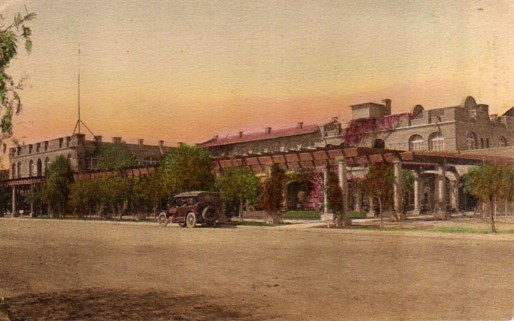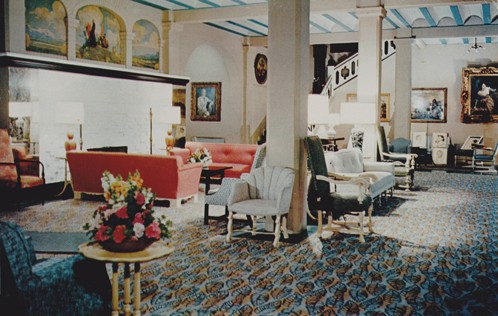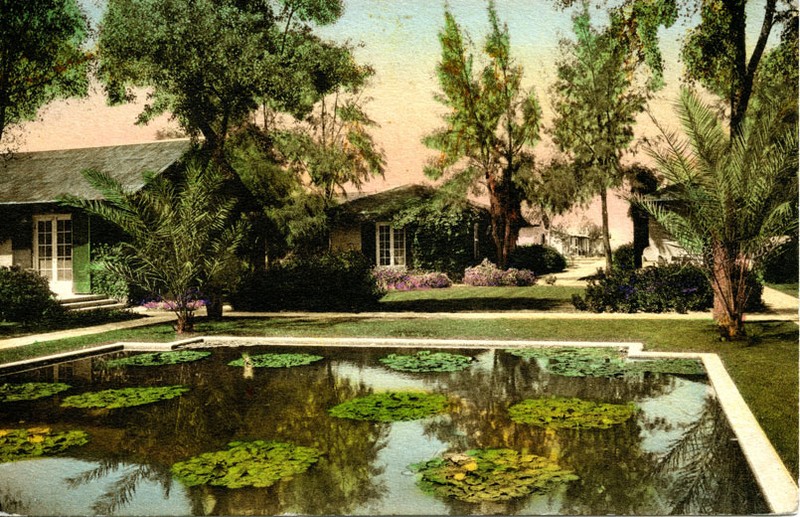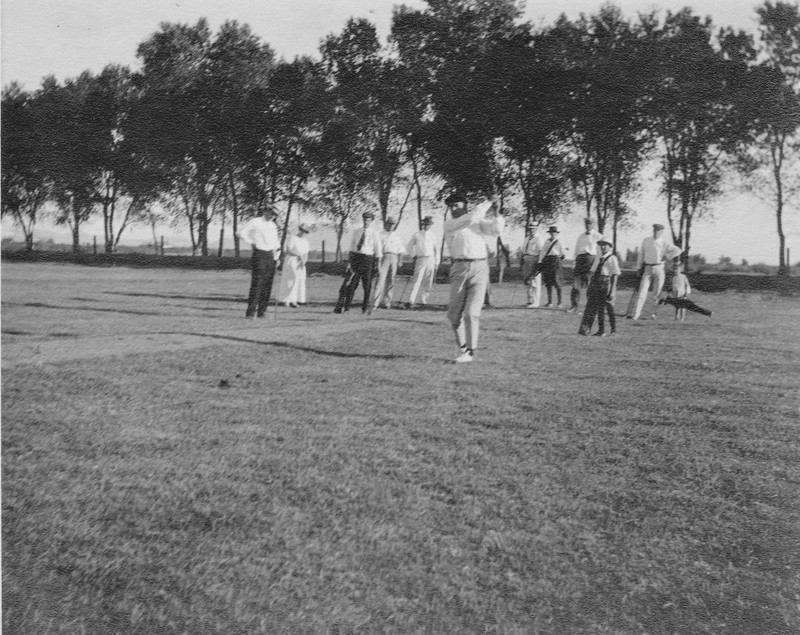The San Marcos Hotel
Introduction
Text-to-speech Audio
Images
San Marcos Hotel, c. 1915

San Marcos Hotel Lobby, c. 1950

San Marcos Bungalows and Gardens, 1937

Original San Marcos Hotel Golf Course, 1913

Backstory and Context
Text-to-speech Audio
The 1911 completion of Roosevelt Dam seemed to ensure a steady supply of water for the valley. Dr. Alexander J. Chandler and his business partners realized that the 18,000 acres of Chandler Ranch would be much more valuable as real estate than farm land. They hatched a plan to create a new community on the south side of the Salt River that would become known as Chandler. At the center of this new town would be a grand resort hotel, the likes of which Arizona had never seen. That hotel would become the San Marcos Hotel.
Dr. Chandler was interested in opening a hotel for more than a decade. He originally planned the grand resort to be constructed in Mesa, but for various reasons those plans fell through. Dr. Chandler then turned his eye towards Chandler Ranch as a location for the resort. His development company, the Chandler Improvement Company, funded the construction of the hotel. He selected a California architect, Arthur Burnett Benton, as the man to design the crown jewel of his empire. Benton was noted for his love of California missions, and his work on the Mission Inn in Riverside, CA. He designed the hostelry in a style known as Mission Revival, reflected in the building’s arched windows and doorways, and its centralized courtyard.
Dr. Chandler wanted the building to be fireproof. The resulting steel reinforced concrete building was the first of its kind in Arizona. Dr. Chandler hired the Los Angeles firm of C. B. Weaver Construction to build the hotel, a company that Benton had hired at the Mission Inn. Work began in the summer of 1912, and Dr. Chandler hoped that the hotel would open that fall.
Unfortunately, the chosen method of construction delayed the project. Rock and cement were shipped form far and wide to the townsite to make the concrete. However, there simply wasn’t enough steel rebar to complete the project in a timely manner. Despite shipping the rebar from as far away as Pueblo, CO, construction dragged into 1913. To add to the challenge of construction, the Pacific Fireproofing Co. installed the Kohn system of fireproofing, a series of metal and plaster partitions, which added more construction time and labor to the project.
Work progressed in stops and starts under three separate superintendents of construction, William R. Hoag, Harry S. Jennings, and Joe Cashman. Slowly the facility with its distinct ribbed ceilings that maximized its strength rose out of the desert. Local bricks from the Chandler Brickyard, were made specifically for the San Marcos. Miles of copper wiring and more than 1,500 electric lights would ensure that the building, the first in Chandler to be electrified, would glitter throughout the day and night. All of the electrical systems were also constructed of state of the art fireproof conduit by chief electrician S. S. Bradley, which added another layer of complexity to the project.
Finally, on November 22, 1913, the San Marcos Hotel opened for business with much fanfare and a grand opening celebration. Five hundred people attended, including Vice President Thomas Marshall, Arizona Governor George W. P. Hunt, and Representative Carl Hayden. Though it took a much longer to construct than he hoped, the hotel became Dr. Chandler’s home and he lived on its grounds until his death in 1950. Since its opening, this shining jewel has been the center of downtown Chandler and an important part of our community. I am sure that the good doctor would be pleased that it was still a vibrant part of the dynamic community that bears his name.
*****
Golf has long played an important role in Arizona’s economy. Historians believe that the first course in the state, the Phoenix Country Club, opened in 1889. Arizona’s first tournament was held there on February 22, 1900. Chandler’s golf history goes back more than a century, to 1913 and the opening of the San Marcos Hotel. The golf course was located across Arizona Avenue from the hotel near the railroad tracks at the intersection of present day Delaware Street and Commonwealth Avenue. The course, designed by Will H. Robinson and Harry Collis, sported a clubhouse a mere stone’s throw from the railroad depot.
Will Robinson was a prolific author who wrote short stories for magazines and published several novels. His wife, Grace, an important figure in her own right, was the first general manager of the hotel. Grace was hired away from her position as manager of Scottsdal’es Ingleside Inn to become the San Marcos’ first general manager. When she moved to Chandler in 1913 to start her new job, Will came with her bringing his considerable talents and energy. Will wrote all of the newspaper columns and advertisements promoting the San Marcos.
Robinson teamed with Harry Collis to design the 100 acre San Marcos course. The two met at the Ingleside Inn where both were golf pros. Collis was an expert at golf course design, having built some of the most famous courses in the country, most notably the Homewood Country Club in Flossmoor, Illinois. In addition, he was a masterful greenskeeper, patented a turf cutting machine, and developed the popular Flossmoor Bent putting green grass. Collis, one of the original snowbirds, spent his summers working at Homewood and wintered in Chandler.
The San Marcos course was laid out in August 1913. It sat on land that, according to Robinson, was ideally situated for a golf course. Robinson and Collis included cotton seed oil greens, sand traps, and even water hazards in their design.
By the fall of 1914, the second season of golf at the San Marcos teed off. Collis came back to the San Marcos as the course pro, and he brought with him noted golf club designer Emil Duwe. Collis and Duwe opened a pro shop in the San Marcos arcade where Duwe fabricated clubs. The store boasted “as complete a line of clubs as can be found in any similar establishment in the country.” The store supplied clubs to other courses in the Valley, including Phoenix Country Club and the Ingleside. Duwe also made a custom set of clubs for town founder and owner of the San Marcos, Dr. Alexander J. Chandler, a few of which reside at the Chandler Museum.
In addition to the shop, Collis and Robinson made a notable change by planting Bermuda grass on the golf course and installing irrigation, making the San Marcos the first grass golf course in the state. They had an innovative plan to keep the grass short: they employed a flock of sheep to eat it, ensuring that the grass would stay short and thick.
The golf course remained popular for thirteen years. By 1926, Chandler’s ostrich herd by the hotel was gone and the hotel was looking to expand. A new plan for downtown Chandler was laid out by Charles Chaney, and as part of the redesign the course was moved to its present location west of the hotel. Over the years the course has been enjoyed by thousands of golfers and has played host to countless tournaments. The course record is held by Johnny Quarty, the son of the hotel’s former owner.
*****
The San Marcos hotel opened in November 1913 with great fanfare, national media attention, and a VIP guestlist a full 500 names long that included leading businessmen and politicians of the time. The luxurious hotel was certainly the gem of early Chandler, despite only being open during the cooler months of the year. It took an awful lot of steam heat to keep the big concrete building warm, especially on the coldest nights of the year. In order to make sure that the wealthy guests at his hotel stayed comfortable, Dr. Alexander J. Chandler had a massive oil furnace installed in the basement of the San Marcos.
The giant furnace, in shape and size not unlike a steam locomotive, was installed more than 20 feet below ground in a subbasement of the hotel, and the rest of the structure was built around it. The smoke stack measured 8 feet by almost 10 feet wide, and towered 30 feet above the rest of the hotel. Clearly this was a machine designed to produce an enourmous amount of steam heat, more than was required of the original 30 guest rooms. In fact, it had been designed to support a hotel more than twice the size of the San Marcos. Original plans for the hotel called for several stories. Only the first two were built in 1913, with the intention of adding more later. But the original furnace had to be large enough to accommodate the entire building, as it would be impossible to expand it once the hotel was built around it.
The size and strength of the furnace was never mentioned in newspaper articles or literature promoting the hotel. This was most likely because Dr. Chandler was promoting the hotel as the place “where summer spends the winter.” He didn’t want his out of state guests to think about cold desert nights, only sunshine and warmth. Nonetheless, a four line note in the January 2, 1914, edition of the local Chandler Arizonan newspaper stated that the 2 month old hotel was installing a concrete oil tank to store fuel oil for the furnace. The new tank would be 18 feet deep.
The furnace heated not only the main hotel building, but also buildings on other properties which belonged to the San Marcos. The Suhuaro Hotel, built across Buffalo Street from the San Marcos, was heated by the furnace. Tunnels under the street carried hot air to the Suhuaro.
Advancements in technology made the San Marcos’ oil furnace obsolete after 20 years. By the mid-1930s, natural gas was popular and had made its way to Chandler. Private residences, businesses, and even the beautiful San Marcos hotel converted to natural gas.
In a June 1936 article, Carl Eckholm, who had taken over operations of the Chandler Improvement Company from Dr. Chandler, crowed about the progress made by installing natural gas. He stated “The inconvenient method which is now necessary to heat the boiler in the San Marcos heating plant will be eliminated. This year with the advent of clean and convenient natural gas. Almost since the founding of the San Marcos it has been necessary to burn wood, coal, and kindling for nearly 24 hours in the hotel’s furnace in order that it might be heated to a degree to handle fuel oil. This year, with natural gas, the entire job can be done in an instant. And that is not all. The worry of the fuel supply will be over. The capacity of our fuel tank is limited. The supply of natural gas is unlimited. We’ll light the furnace about November 15 and forget it until closing time in the spring.” It would have the additional benefit of keeping the hotel clean –soot build up from the oil furnace had ruined furniture on the sun porch on numerous occasions.
The oil furnace was never used again after natural gas was installed at the hotel in 1936. It was far too large to be removed, so walls were built around it. To this day, however, it sits in the basement of the hotel, a forgotten monument to the founding of the San Marcos, and a source of myths about gangsters using its ventilation shafts as escape tunnels.
Cite This Entry
Museum, Chandler. "The San Marcos Hotel." Clio: Your Guide to History. January 31, 2020. Accessed March 14, 2025. https://theclio.com/entry/93850
Sources
Chandler Museum archives
Crago, Jody, Mari Dresner, and Nate Meyers. Images of America: Chandler. Arcadia Publishing, Charleston, SC, 2012.
"Building the San Marcos Hotel." http://chandlerpedia.org/Exhibits/Chandler_Republic_Newspaper_Arictles/Chandler_Republic_Newspaper_Articles%2C_p._2/Week_11%3A_Building_the_San_Marcos_Hotel
"Arizona's Original Grass Golf Course." http://chandlerpedia.org/Exhibits/Chandler_Republic_Newspaper_Arictles/Chandler_Republic_Newspaper_Articles%2C_p._2/Week_10%3A_Arizona's_Original_Grass_Golf_Course
http://chandlerpedia.org/Collections/Archival_Items/Photos/Businesses/San_Marcos_Hotel/Exterior_views_of_the_San_Marcos
http://chandlerpedia.org/Collections/Archival_Items/Photos/Businesses/San_Marcos_Hotel/Lobby/86.52.17
http://chandlerpedia.org/Collections/Archival_Items/Postcards/San_Marcos_Hotel_Postcards/Bungalows_of_the_San_Marcos_Hotel/08.52.79
http://chandlerpedia.org/Exhibits/Chandler_Republic_Newspaper_Arictles/Chandler_Republic_Newspaper_Articles%2C_p._2/Week_10%3A_Arizona's_Original_Grass_Golf_Course

